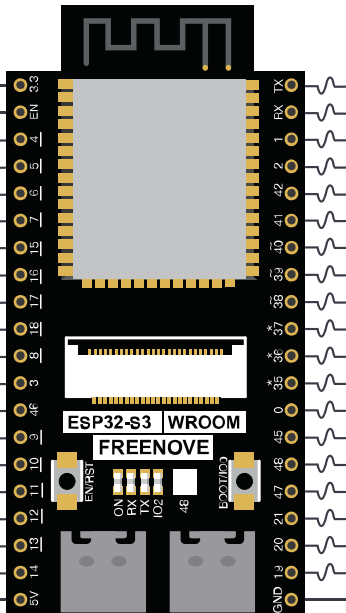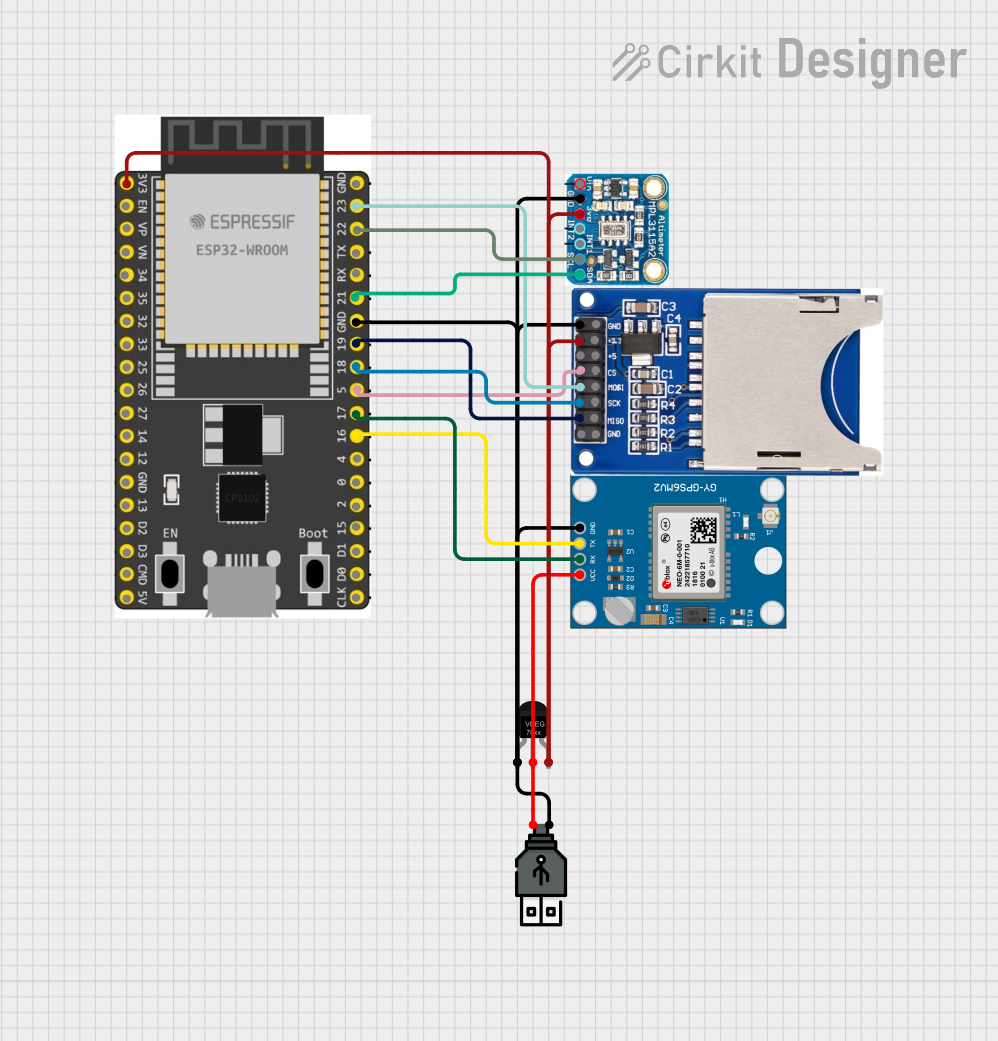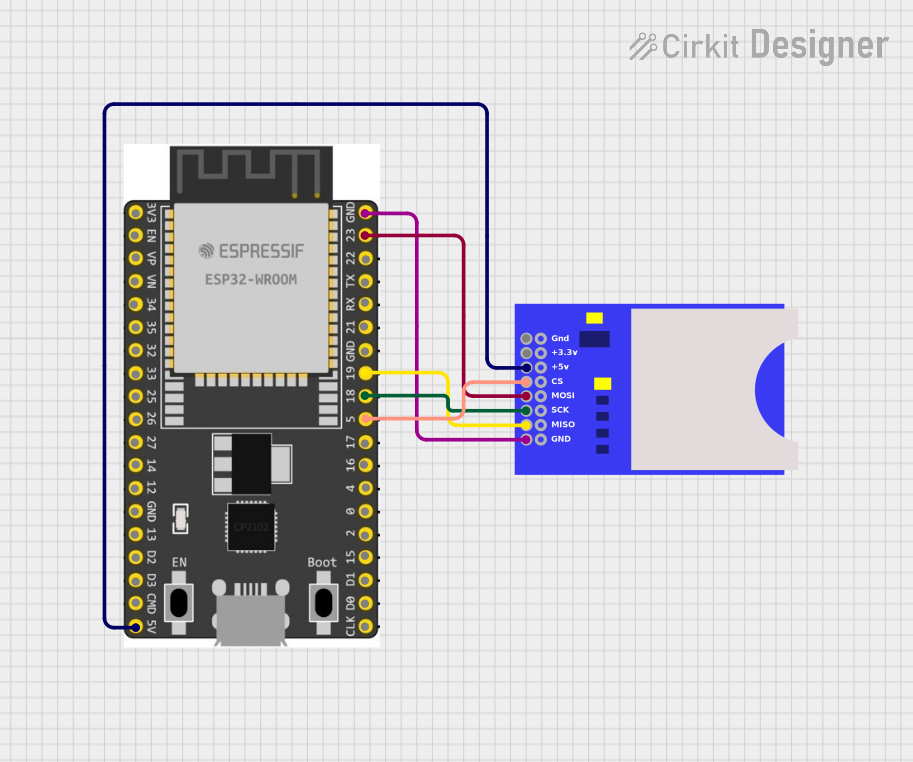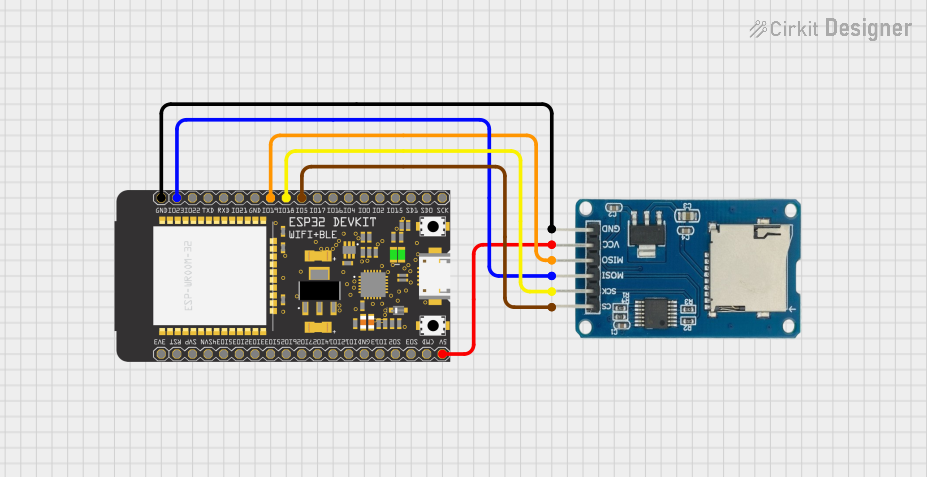
How to Use ESP32-S3 WROOM: Examples, Pinouts, and Specs

 Design with ESP32-S3 WROOM in Cirkit Designer
Design with ESP32-S3 WROOM in Cirkit DesignerIntroduction
The ESP32-S3 WROOM, manufactured by Freenove (Part ID: ESP32), is a powerful microcontroller module designed for Internet of Things (IoT) applications. It features integrated Wi-Fi and Bluetooth capabilities, a dual-core processor, and a wide range of GPIO pins, making it ideal for projects requiring wireless communication, edge computing, and versatile connectivity.
Explore Projects Built with ESP32-S3 WROOM

 Open Project in Cirkit Designer
Open Project in Cirkit Designer
 Open Project in Cirkit Designer
Open Project in Cirkit Designer
 Open Project in Cirkit Designer
Open Project in Cirkit Designer
 Open Project in Cirkit Designer
Open Project in Cirkit DesignerExplore Projects Built with ESP32-S3 WROOM

 Open Project in Cirkit Designer
Open Project in Cirkit Designer
 Open Project in Cirkit Designer
Open Project in Cirkit Designer
 Open Project in Cirkit Designer
Open Project in Cirkit Designer
 Open Project in Cirkit Designer
Open Project in Cirkit DesignerCommon Applications and Use Cases
- Smart home devices (e.g., smart lights, thermostats)
- Wearable technology
- Industrial IoT systems
- Wireless sensor networks
- Robotics and automation
- Edge AI and machine learning applications
Technical Specifications
The ESP32-S3 WROOM is a high-performance module with the following key specifications:
| Parameter | Value |
|---|---|
| Microcontroller | Dual-core Xtensa® LX7 processor |
| Clock Speed | Up to 240 MHz |
| Flash Memory | 4 MB (expandable in some variants) |
| RAM | 512 KB SRAM |
| Wireless Connectivity | Wi-Fi 802.11 b/g/n, Bluetooth 5.0 (LE) |
| GPIO Pins | 45 (including ADC, DAC, PWM, I2C, SPI, UART, and more) |
| Operating Voltage | 3.3V |
| Input Voltage Range | 3.0V to 3.6V |
| Power Consumption | Ultra-low power consumption in deep sleep mode (as low as 10 µA) |
| Operating Temperature | -40°C to 85°C |
| Dimensions | 18 mm x 25.5 mm |
Pin Configuration and Descriptions
The ESP32-S3 WROOM has a versatile pinout. Below is a table summarizing the key pins and their functions:
| Pin Name | Type | Description |
|---|---|---|
| GPIO0 | Input/Output | General-purpose I/O, boot mode selection |
| GPIO1 | Input/Output | General-purpose I/O, UART TX |
| GPIO2 | Input/Output | General-purpose I/O, ADC, DAC |
| GPIO3 | Input/Output | General-purpose I/O, UART RX |
| GPIO4 | Input/Output | General-purpose I/O, PWM, ADC |
| GPIO5 | Input/Output | General-purpose I/O, SPI, PWM |
| EN | Input | Enable pin, used to reset the module |
| 3V3 | Power | 3.3V power supply input |
| GND | Power | Ground connection |
| VIN | Power | Input voltage (3.0V to 3.6V) |
For a complete pinout diagram, refer to the official Freenove ESP32-S3 WROOM datasheet.
Usage Instructions
How to Use the ESP32-S3 WROOM in a Circuit
- Powering the Module: Connect the VIN pin to a 3.3V power source and GND to ground. Ensure the power supply is stable and within the specified voltage range.
- Programming the Module: Use a USB-to-serial adapter or a development board to upload code to the ESP32-S3 WROOM. The module supports programming via the Arduino IDE, PlatformIO, or the ESP-IDF framework.
- Connecting Peripherals: Use the GPIO pins to connect sensors, actuators, or other peripherals. Ensure the connected devices operate at 3.3V logic levels to avoid damage.
- Wireless Communication: Configure the Wi-Fi and Bluetooth settings in your code to enable wireless communication.
Important Considerations and Best Practices
- Voltage Levels: The ESP32-S3 WROOM operates at 3.3V. Avoid connecting 5V logic devices directly to its GPIO pins.
- Heat Management: While the module is efficient, prolonged operation at high clock speeds may generate heat. Ensure proper ventilation or heat dissipation in your design.
- Deep Sleep Mode: Use the deep sleep mode to conserve power in battery-operated projects.
- Boot Mode: To enter boot mode for programming, hold GPIO0 low while resetting the module.
Example Code for Arduino UNO Integration
Below is an example of how to use the ESP32-S3 WROOM with the Arduino IDE to connect to a Wi-Fi network:
#include <WiFi.h> // Include the Wi-Fi library for ESP32
// Replace with your network credentials
const char* ssid = "Your_SSID";
const char* password = "Your_PASSWORD";
void setup() {
Serial.begin(115200); // Initialize serial communication at 115200 baud
delay(1000); // Wait for a second to stabilize the serial monitor
Serial.println("Connecting to Wi-Fi...");
WiFi.begin(ssid, password); // Start connecting to the Wi-Fi network
while (WiFi.status() != WL_CONNECTED) {
delay(500); // Wait for 500ms before checking the connection status again
Serial.print("."); // Print a dot to indicate progress
}
Serial.println("\nWi-Fi connected!");
Serial.print("IP Address: ");
Serial.println(WiFi.localIP()); // Print the assigned IP address
}
void loop() {
// Add your main code here
}
Troubleshooting and FAQs
Common Issues and Solutions
Module Not Powering On:
- Ensure the VIN pin is supplied with a stable 3.3V power source.
- Check all connections for loose wires or poor solder joints.
Unable to Upload Code:
- Verify that the correct COM port and board type are selected in the Arduino IDE.
- Ensure GPIO0 is held low during the reset process to enter boot mode.
Wi-Fi Connection Fails:
- Double-check the SSID and password in your code.
- Ensure the Wi-Fi network is within range and not using unsupported security protocols.
GPIO Pin Malfunction:
- Confirm that the connected peripherals are operating at 3.3V logic levels.
- Avoid exceeding the maximum current rating of the GPIO pins (12 mA per pin).
FAQs
Q: Can the ESP32-S3 WROOM operate on 5V?
A: No, the module operates at 3.3V. Supplying 5V directly to the module may damage it.
Q: How do I reset the module?
A: Pull the EN pin low momentarily to reset the module.
Q: Can I use the ESP32-S3 WROOM for Bluetooth audio applications?
A: Yes, the module supports Bluetooth 5.0, which can be used for audio streaming and other Bluetooth applications.
Q: What is the maximum Wi-Fi range of the ESP32-S3 WROOM?
A: The range depends on environmental factors but typically extends up to 100 meters in open spaces.
For additional support, refer to the official Freenove documentation or community forums.